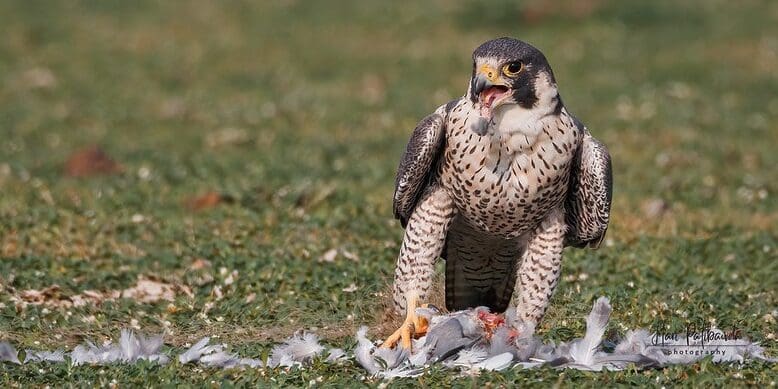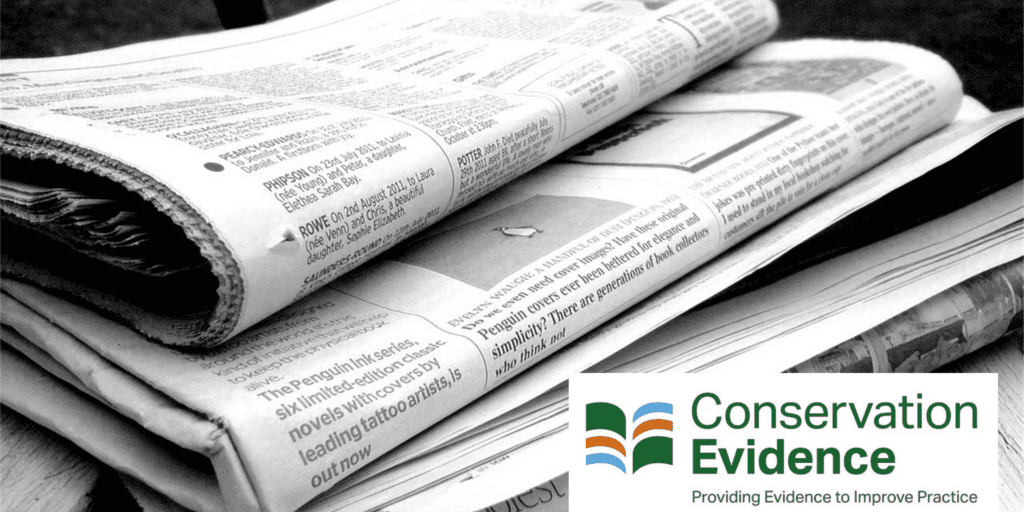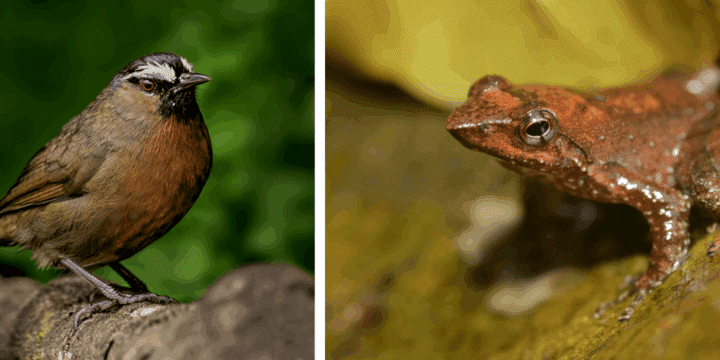Evidence-based conservation with Mossy Earth: encouraging lessons and challenges
This blog was written by Tiago de Zoeten, Conservation Biologist at Mossy Earth.

1) What we do at Mossy Earth and how evidence fits into the picture
At Mossy Earth we work to restore nature across a wide range of ecosystems while being as cost-effective and transparent as we can. We are funded by a community of enthusiastic members who make monthly contributions that allow us to carry out all kinds of on the ground actions. These can range from restoring floodplain forests in the Danube to planting trees in Iceland or testing kelp forest restoration techniques in Portugal. In the process, we are continuously making complex decisions about if and how to intervene in nature. By designing the processes needed to integrate the best available evidence into these decisions we believe that we will be able to achieve much more with our limited resources. We also see evidence generation as a form of impact: by improving our knowledge of what works and what doesn’t and sharing this with others we hope to help improve outcomes beyond the projects we are directly involved in.
To help us put these principles into practice we have established a partnership with the Conservation Evidence team at the University of Cambridge. They have been spearheading the movement towards evidence-based conservation from the very beginning by arguing for its importance and providing very useful free resources that make it easier to put into practice. We are part of the Evidence Champions programme and have counted on their support to help us design our current approach to selecting, planning and monitoring our projects. This is very much a work in progress for us, but here I will try to share some of the lessons we have learned so far and some of the challenges we are still grappling with. I hope that sharing the lessons can help others put evidence-based conservation into practice and that sharing the challenges will bring back some suggestions about how we can do things better.
2) How we are integrating evidence into our procedures
Project selection and development
Depending on the project, our team may play the role of funders, practitioners or both. In each case we follow the same approach to integrating evidence into decisions. The first place evidence comes in is at the stage of deciding if a project idea is worth pursuing and moving to the planning stage. At this stage, the team designing the project answers two simple questions:
Question 1: What evidence is there to suggest the intervention will be effective?
- The project is experimental and based only on individual expert opinions or mechanism based reasoning.
- The project is based on anecdotal evidence from similar projects but these have not been scientifically reported OR it is based on scientific evidence that may or may not apply locally.
- The project is based on scientific evidence from similar projects.
- The project is based on a review and evidence synthesis from a wealth of similar projects.
Question 2: What are the main project outcomes and how will they be monitored?
Although very simple, this often provides us with enough information to understand how evidence fits into the project. It also makes it easy to spot situations where the evidence base is weak and the monitoring approach is not sufficiently rigorous to generate actionable evidence for the future. We will either stop pursuing the project idea or will redesign it to ensure that it delivers direct conservation impact, allows us to learn an important lesson or both.
Project planning
It is at the planning stage that we carry out a more thorough review of evidence and where we detail the actual monitoring approach. The project team is asked to come up with a theory of change which is essentially a description of how and why a desired change is expected to happen in a particular context. From this, we attempt to extract the key claims that would require evidence for this theory of change to hold. We then lay these out in a simple table that lists each claim and a description of what evidence supports it. This makes it easy to spot where the evidence is weaker and provides a good record for the rationale behind the project design which can be revisited during and after implementation.

3) Encouraging lessons
Assessing the evidence early matters
This can help us to steer project design before more time and effort is put into planning a specific course of action. This is important because it allows us to evaluate alternatives at a stage where decisions are less likely to be affected by commitment and confirmation bias. What’s more, it can help us save time and money and prevent any friction or confusion that may arise from an evidence-led change of plans further down the line.
An evidence review can pay off in multiple ways
Reviewing evidence can take time which could be dedicated to other aspects of a project and this is a trade-off we have to navigate well to maximize our impact. However, we have found that taking the time to clearly lay out the evidence behind specific claims has benefits that go beyond improving the design of the project itself. When we find that there is robust evidence for each claim and the rationale is very sound, the management plan becomes a very clear justification for the chosen course of action. This can help gather buy-in from stakeholders and allows us to communicate with more confidence about the project. On the other hand, if there is limited evidence to support some of the key claims or assumptions, the project team can seek alternative actions to achieve the same objectives. Alternatively, it may be possible to use an experimental design that allows new evidence to be generated to test the assumptions that are on shaky grounds. In this way, the evidence review is also helping direct research attention where it is most needed. If done correctly this process should allow us to ensure that every project delivers direct conservation impact, allows us to learn an important lesson or both.
People respond well to the communication of uncertainty and negative results
It is part of our ethos to be as transparent as we can about our projects. We make management plans publicly available which allows anyone to see a budget breakdown for the objectives and planned activities. We also work hard to provide continuous updates about the projects through social media which keeps us accountable. By announcing our intentions before implementing an action we are committing to reporting on the outcomes whether they are good or bad.
Not all projects go according to plan and we will not make the right decision every time. This approach of having a more direct and “unpolished” communication with our supporters makes it easier for others to point out problems and mistakes which could be perceived as a reputational risk. However, our experience is that people respond very well when we communicate the uncertainty that is inherent to some of our actions and appreciate it when we communicate negative results. The lesson so far for us is that sharing everything by default and only holding back information where it is sensitive (e.g. location of rare species, personal information) leads to more trust and engagement and sometimes to some very useful criticism and suggestions.

4) And a few challenges
There is still a lot of room for improvement in terms of our approach to using and generating evidence and we have identified some challenges as we make progress in this front.
Lack of locally relevant evidence
When reviewing the evidence for an action we seek to implement we are often faced with the problem that it is hard to judge how relevant it is to the exact area or species we are intervening on.
Lack of baseline data
One of the challenges we face is the absence of comprehensive baseline data for the species or ecosystems we are focusing on. In some of these cases, designing the project in a way that allows us to infer cause and effect may require us to postpone implementation and increase the overall project budget. Choosing if that’s the appropriate thing to do is not always straightforward as we have to weigh how confident we are that the action will be effective (based on existing evidence), how urgent the intervention is and how important it is for us to rule out any confounding factors in this particular instance.
Ecological change takes time
Ecological change typically occurs over extended periods of time. This means that actually demonstrating change requires a commitment to long term monitoring that can be difficult to fund and organize.
Complex interventions and causality
Causal inference becomes challenging when multiple interventions are carried out simultaneously or when the approach changes as the project progresses. This is common in landscape scale rewilding projects where multiple issues are addressed simultaneously to maximize impact. This means that a lot of the evidence practitioners need will have to be extracted from quasi-experiments which are not as straightforward to carry out and interpret.
Generating evidence demands capacity
Developing more robust experimental designs often requires additional time and resources for planning, monitoring, and data analysis and this is not always possible to arrange. As a small organization it is not easy for us to carve time away from project management and allocate it to publishing scientific evidence. Where possible we are establishing collaborations with universities and research students to help us overcome this challenge and are looking for ways to be faster at publishing the evidence we collect.

5) A comment on technology: a potential game changer or a distraction?
Advances in technology, such as drones, satellite monitoring, artificial intelligence (AI), and environmental DNA (eDNA) analysis, offer great potential for enhancing our ability to gather data cost-effectively. Drones and satellite monitoring provide valuable tools for mapping and monitoring ecosystems at various scales, enabling us to collect spatially explicit data on habitat characteristics, species distributions, and landscape changes. AI algorithms can assist in processing and analyzing large datasets, identifying patterns, and making predictions, thereby accelerating our understanding of complex ecological systems. Furthermore, eDNA analysis allows us to detect the presence of species in environmental samples, offering a non-invasive and efficient method for biodiversity monitoring over time. We are already using many of these tools in our projects and we expect they will become more important over time. As the cost of data collection goes down, the case for evidence-based practice will only grow stronger.
Having said this, it is very easy to get carried away by the excitement of these new technologies and they can become a distraction. It is easy to collect large amounts of sophisticated data that is not very useful because it is not integrated into a sound experimental framework. There is no replacement for thinking carefully about project design and monitoring and in many many cases, the most cost-effective approach will be to use a simple low-tech monitoring protocol.
Mossy Earth are a Conservation Evidence Evidence Champion. Evidence Champions are organisations with a clear commitment to involve Conservation Evidence and other relevant sources of scientific evidence in their work.




An interesting read,Tiago. Keep up the good work.